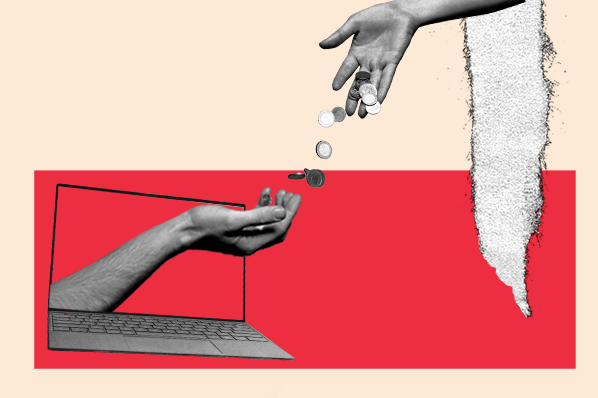Customer Service Phrases to Avoid
- "Give me one second to look into that ... "
- "Unfortunately, no ... "
- "I can't help with that."
- "Actually ... "
- "You misheard me."
- "I'm sorry."
- "Can I put you on hold?"
- "I don't see your account information in our database."
- "That's not something I can do."
- "Can I call you back?"
- "Can you remind me what your last name and phone number are?"
- "Uhh..."
- "I don't know."
- "This looks like a glitch."
Before we dive into these phrases in-depth, it's important to note that the use of each one will vary by industry, company, and customer needs. Not all service cases are the same and in some instances these phrases need to be used to appease a customer. It all depends on the customer's needs and what you can provide them at that time.
1. "Give me one second to look into that ... "
When helping a customer work through a problem, you really want to flex your direct communication skills. This isn't to say you should be insensitive or argumentative, but rather you should aim to:
- Set expectations. Are you going to put them on hold while you dig in? How long do you expect this to take? Be upfront.
- Define your plan of action. What exactly are you looking into? Are you going to check their account information? Ask a colleague? Let them know you actually have a plan and you're not just scrambling.
2. "Unfortunately, no ..."
You might be thinking, "Is there really a good way to say 'no'?"
Turns out, there are ways to soften the blow and provide a better experience for the customer, even when you can't accommodate their request entirely. But by leading with the negative, you might make customers upset or angry.
3. "I can't help with that."
This is a comeback that customer service and customer success professionals fall back on when they are limited by policies and protocol -- when the organizations they work for put process over people.
To combat this, it's important to first surface this as a concern to senior management, as the decision to remove or reduce restrictive policies typically falls in their court.
And if you need an example to support this idea, point them to the Ritz-Carlton, where employees are trusted to make decisions and given $2,000 a day to use towards customer delight:
"Sometimes the most delightful 'wow' moments happen in the blink of an eye. If employees are not empowered and need to cross layers of approval, these moments could be lost forever," explains a Senior Account Executive from the luxury hotel chain.
4. "Actually, ... "
But, but, the customer is always right, right?
When dealing with a situation where a customer is misunderstanding the way something works, take a minute to remember that you've made mistakes before too -- and this is not the time and place to flex your authority or come off as accusatory.
Believe it or not, Apple has gone as far as creating a rule against employees correcting customer mispronunciations, as they feel it's both condescending and rude to do so, according to an article from Business Insider.
5. "You misheard me."
Giving and receiving information isn't always easy, especially when the customer is feeling frustrated or confused.
Rather than allowing emotions to muddy up your communication, take accountability for ensuring that the customer fully understands the situation and all of the possible outcomes.
6. "I'm sorry."
The phrase "I'm sorry" is often used as a crutch phrase -- one that carries little significance or impact when used out of context.
In other words:
- Don't say sorry when you really mean, "I'll have to look that up."
- Don't say sorry when you really mean, "Can I ask you a question?"
- Don't say sorry when you really mean, "I want to understand the problem better."
7. "Can I put you on hold?"
No customer wants to be put on hold -- especially when you're putting them on hold to address someone else's problem. Unfortunately, there are circumstances when this is unavoidable.
If you have to ask a customer to hold, ask them first. In some circumstances, they might not have the time to wait and would prefer to call back later.
8. "I don't see your account information in our database."
Want to send a customer over the edge? Say this. There's nothing more frustrating than reaching out for help only to be met with disorganization on the other end.
If you find yourself leaning on this phrase a lot, you'll likely benefit from investing in some customer service software. Software like this has the ability to increase transparency and collaboration across departments, so you're never left at a loss when you realize the notes from the customer's last call are hiding in your colleague's inbox.
9. "That's not something I can do."
Even if a customer's request exceeds your pay grade or permissions, it's still your responsibility to direct them towards a solution.
Rather than letting the customer know what you can't do, make it clear what you can do by connecting them with someone who can help straight away.
10. "Can I call you back?"
Sometimes, you might need to stop the conversation so you can consult with your team and do some digging on a bigger issue your customer calling in has raised.
When this situation comes up, don't phrase your next response in terms of what you need.
11. "Can you remind me what your last name and phone number are?"
Ask anyone with a last name that's longer than 10 letters: Spelling out your name over the phone is the worst.
And depending on the phone system you have, your customer might have already had to enter their phone number or utter their last name at a robot in order to get in touch with you.
So make sure you're using software that keeps track of customer information -- including history -- so you have the context you need to address their issues. It doesn't hurt to take notes as you're talking to make sure you have the information you need on hand.
12. "Uhh…"
This one can be hard to avoid and you may actually say it without even realizing it. Phrases like "uhh," "um," "erm," "like," and "so" are vocal disfluencies that we use when speaking. They act as pauses that give us a moment to think about what we're saying before we say it.
The problem with disfluencies is that they project a lack of confidence. If you're constantly saying "um" when you're relaying troubleshooting steps, customers may not understand what you're saying or they might not trust that the information you're giving them is accurate. When you're communicating with customers, you need to speak clearly and remove any disfluencies that can cause a distraction.
13. "I don't know."
But, if you don't know, who will?
Remember you're the expert. You're answering the phone because you're the best resource to help the customer. By saying "I don't know," you're forfeiting some of your credibility as a customer support rep. If the customer is in a hurry, they may not have time for you to look for a solution or to ask a teammate for help. Instead, they'll insist to be transferred to someone who can provide them with an immediate solution.
14. "This looks like a glitch."
If you work for a SaaS company, you may come across small abnormalities in your company's product. While it may be tempting to call these problems "glitches" it's important to avoid this phrase when speaking with customers.
When you use terms like "glitch," "glitchy," "bug," or "buggy," it damages the integrity of your product. It makes the customer feel like your product has inconsistencies and there will be times when they can't rely on it.
Positive Phrases for Customer Service
- "This is possible, but I need to run a report first. This will only take two or three minutes, would you like me to place you on hold while I process it?"
- "I understand your frustration."
- "I understand why you'd want that."
- "I want to check that we're both on the same page."
- "What I'm hearing is [ISSUE]. Is that correct?"
- "I want to make sure I understand your issue ... "
- "Would you mind if I put you on hold for a moment so I can dig into this further for you?"
- "Would you mind giving me a minute to double-check your account?"
- "As much as I'd love to help with that ... "
- "I want to double-check with my team before giving you an answer so I don't waste your time. When's a good time for us to schedule a follow-up call?"
- "I want to make sure I'm not repeating myself."
- "Let me confirm that,"
- "This look like abnormal behavior from this product."
1. "This is possible, but I need to run a report first. This will only take two or three minutes, would you like me to place you on hold while I process it?"
Instead of saying "Give me one second to look into that ... ," give customers a clear timeframe and tell them how you're going to help them so they know they aren't just waiting on hold for an eternity.
2. "I understand your frustration."
Instead of saying, "Unfortunately, no ... ," try offering up the best possible alternative first -- it may end up being just what they need.
Can't think of an alternative right off the bat? Try asking a few clarifying questions first. By drawing out more detail, you may find that there is, in fact, a way to offer them support -- or at least meet them in the middle. And when in doubt, a little empathy can go a long way.
3. "I understand why you'd want that."
Instead of saying, "I can't help with that," think about what resolution you can offer the customer. Even if there's no wiggle room to reduce policies and protocol, there's always something you can do, even if it's just listening and passing feedback along to your team.
4. "I want to check that we're both on the same page."
Instead of starting with "Actually ... ," which can come across like you're a know-it-all, keep your tone helpful and upbeat while asking clarifying questions so the customer doesn't feel condescended to or chastised.
5. "What I'm hearing is [ISSUE]. Is that correct?"
Instead of saying, "You misheard me," ask reflective questions to make sure you and the customer fully understand one another. What's obvious to you, might not be so obvious to someone lacking proper context.
This might mean that you need to adjust your communication style to ensure that you're clearly stating your intentions and conveying your willingness to help, regardless of any confusion that may have taken place.
6. "I want to make sure I understand your issue ... "
Instead of immediately apologizing, ask for more clarity on the situation, and thank the customer for taking the time to help you help them. And if youaregoing to apologize, follow it up with a solution. Customers want to know that you're actually going to do something about the mistake or miscommunication.
7. "Would you mind if I put you on hold for a moment so I can dig into this further for you?"
Before asking if you can put your customer on hold, make sure you explain why you're putting them on hold to help them gauge expectations. If the hold is taking longer than anticipated, hop back on to let them know you appreciate their patience. Explain the situation and reset their expectations.
8. "Would you mind giving me a minute to double-check your account?"
Instead of saying that you can't find the customer's account information (and, likely, inciting a panic), buy yourself some time and ask if you can double-check for them. This will make sure you know exactly what the issue is before getting back on the phone to avoid confusing or unnecessarily angering the customer.
9. "As much as I'd love to help with that ... "
Instead of saying that you can't do what the customer is asking -- and effectively crossing your arms over the phone -- think back to #3. Offer a more neutral explanation of the restrictions of your scope, but don't end the conversation there.
In most cases, this phrase can be prevented by surfacing the negative impact that these type of role restrictions cause with your senior management. Perhaps there's room to create more flexible permissions to avoid having to climb the latter every time you need to perform a certain task for a customer.
10. "I want to double-check with my team before giving you an answer so I don't waste your time. When's a good time for us to schedule a follow-up call?"
Instead of asking if you can call them back, phrase your response as trying to be more helpful and accommodating to the customers' time. Sure, you might be the one who needs to hang up the phone to get to the bottom of the issue, but this small phrasing tweak can make a world of difference for your customer's perception.
11."I want to make sure I'm not repeating myself."
Instead of asking customers to repeat themselves, this phrase will buy you some time to check your records while still making sure the customer is engaged and happy.
12. "Let me confirm that for you."
If a customer does stump you with a question, there are other ways to tell them you need to research the answer. For example, you could say, "My gut tells me the answer is this, but let me confirm that solution for you." This gives you a little wiggle room in case your first guess is incorrect. The worst that can happen is that you'll return to the customer and say, "actually, turns out the answer was this, good thing we checked."
Even if your initial guess is correct, the customer will still appreciate that you went the extra mile to confirm a solution. This shows that you take care in your work and you aren't just trying to close support tickets.
13. "This look like abnormal behavior from this product."
Instead of using terms like "glitch" or "bug," try to use the phrase "abnormal behavior" when you're describing small problems with a software or product. This tells the customer that even though the product isn't working as expected, these types of problems are uncommon.
It doesn't exaggerate the issue or make excuses for your business. Rather, it shows that you have the situation under control and have properly diagnosed the problem.
Remember: We're All Human.
Being in a customer-facing role can be taxing -- especially when you're not equipped with the proper tools and permissions to help a customer quickly get to a solution. Luckily, you're in control of how you choose to respond.
This isn't to say that you should constantly feel like you're walking on eggshells, but you should be conscious and strategic in how you handle customer communications. Put yourself in the shoes of the person on the other end of the line, and show some empathy -- trust us, it'll go a long way.
.png?width=112&height=112&name=Image%20Hackathon%20%E2%80%93%20Vertical%20(57).png)
.jpg)


![24 best contact us pages you'll want to copy [+ templates]](https://53.fs1.hubspotusercontent-na1.net/hubfs/53/contact-us-page-1-20251028-243229.webp)

![How to Respond to Customer Complaints [+Complaint Response Examples]](https://53.fs1.hubspotusercontent-na1.net/hubfs/53/Copy%20of%20Featured%20Image%20Template%20Backgrounds%20(8)-1.png)


![How to Write an Apology Letter to Customers [12 Templates & Examples]](https://53.fs1.hubspotusercontent-na1.net/hubfs/53/ai%20customer%20service%20predictions%20(6).png)


